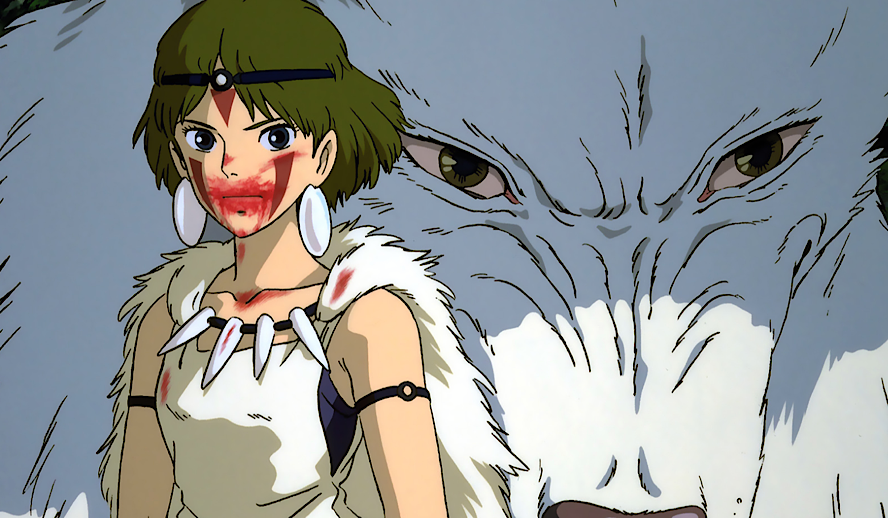Table of Contents

Photo: ‘Princess Mononoke’
What Was (Almost) a Grand Finale
Picking a favorite film by legendary director Hayao Miyazaki is difficult. In the span of his long and winding career, Miyazaki has directed a dozen features, all of which have grounds for being one’s “favorite.” ‘Spirited Away’, his big comeback film which won the Academy Award for Best Animated Feature in 2003, is generally held as objectively the best, but that’s not the same as picking favorites; as for myself, if someone twisted my arm and forced me to choose, I would pick ‘Princess Mononoke’ virtually every time.
‘Princess Mononoke’ was originally billed as Miyazaki’s final film, after working in Cinema and TV for three decades already, and had this really been the case, Miyazaki’s reputation as the seminal figure in Japanese animation would remain very much intact. Indeed, ‘Princess Mononoke’ feels like the end of something — a culmination of themes and values that had defined the maestro’s career up to that point, and which he would only somewhat return to in the four features he would direct afterward.
Related article: OSCAR-NOMINATED – EXCLUSIVE: ‘Dune’ Full Commentary, Reactions, Making Of – Timothee Chalamet, Zendaya, Oscar Isaac
Related article: OSCAR-NOMINATED – ‘House of Gucci’ Full Commentary & Behind the Scenes – Lady Gaga, Adam Driver, Jared Leto, Al Pacino
While ‘Spirited Away’ and ‘The Wind Rises’ (also billed as Miyazaki’s farewell to Cinema, but apparently that didn’t stick either) are certainly epic and visionary, neither comes even close to capturing the sheer scale of ‘Princess Mononoke’, a film that almost feels more like a sandbox than a conventional movie with its vast lived-in world, its warring factions, and its undying loyalty to Nature (capitalized in Miyazaki’s worldview). At 134 minutes, it’s still Miyazaki’s longest feature, and by extension one of the longest animated films ever made, only topped in recent years by fellow Studio Ghibli helmsman Isao Takahata’s ‘The Tale of the Princess Kaguya’ (137 minutes) and ‘The Disappearance of Haruhi Suzumiya’ (a mammoth 162 minutes). The result, when one combines length, scope, and content, puts Miyazaki’s almost-finale more in line with Peter Jackson’s ‘Lord of the Rings’ trilogy than anything produced by Pixar or Walt Disney Animation Studios.
Yet for all its promises of brutal action (and it is a remarkably violent movie), ‘Princess Mononoke’ is held as a classic today in no small part due to its moral complexity, the depth of its characters, and how it serves as Miyazaki’s grandest artistic statement as both a humanist and an environmentalist.
Related article: EVOLUTION: Every Henry Cavill Role From 2001 to 2021, All Performances Exceptionally Poignant
Related article: EVOLUTION: Every Chris Evans Role From 1997 to 2020, All Performances Exceptionally Poignant
This article contains plot spoilers for ‘Princess Mononoke’, of course.
The Cursed Man, the Wolf Girl, and the Iron Lady
The movie takes place in an alternate feudal Japan where gods of the forest are given corporeal form — and can be killed. We start with Ashitaka, the prince of a minor village who seems far more well-equipped with a bow and arrow than with emotional expression; his stoicism, however, will prove to be a useful asset for the eventual conflict. For now, a boar god, apparently driven mad by a curse, threatens to destroy the village in a blind rage — his body essentially rotting while he is still alive, the transparent tentacles of the curse killing him slowly but surely. Ashitaka takes down the boar god, but not before his right arm is infected with the same curse, and like a leper, he is exiled from all he knows, driven into the wild world to find a cure or else face death — assuming the curse doesn’t drive him to insanity first. The biggest criticism I hear directed at Ashitaka is that he’s not as colorful a personality when compared to some other Miyazaki protagonists, and he’s certainly not as flamboyant as certain other characters in his own movie, but I would argue that Ashitaka’s lack of flaws makes him the perfect arbiter between the two biggest sides in conflict.
In nearly any other movie, San would probably serve as the protagonist — presumably our point-of-view character. San is a human woman raised by a wolf god and her kin, and as such, she has a predisposed hatred for civilization; she’s knowledgeable in how the forest operates, but she has no “people” skills. When Ashitaka and San first meet (Ashitaka not being in much of a mood to talk, having taken a grievous bullet wound), the latter wants to kill the former, and nearly does; naturally, they are made for each other.
Related article: #metoo Revolution: Powerful Questions That Need Answers
Related article: FACT-CHECKED Series: Timothee Chalamet and 32 Facts about The Young Superstar
San, in her righteous but overzealous fury towards mankind, represents one end of the scale: the angel of death, serving the needs of Nature on its behalf. Ashitaka’s life is spared only because the forest sprites (weird little bobbleheads with holes for eyes) had already taken a liking to him, and once Ashitaka and San are on speaking terms, they start to understand each other’s wants. However, for Ashitaka, bringing peace to the forest (as well as finding a cure for his arm) takes precedence over giving into every one of San’s whims.
We then arrive at our third and final piece of the puzzle: Lady Eboshi, the leader of Iron Town. Up to this point in the movie, we have been almost entirely immersed in Nature, with Ashitaka’s village being all but engulfed by the trees and grassy hills; Iron Town, however, is a comparatively advanced society on the brink of industrialization. Unlike Ashitaka’s village, which is held together with one of those little Elmer’s glue bottles you used in elementary school, or the animal tribes, which are fractured and nomadic, the people of Iron Town live in harmony with each other, and they greatly respect Lady Eboshi. Eboshi is such a great character (really one of Miyazaki’s finest creations) that she deserves her own titled section, but we’ll get to her in a moment. There are some other notable supporting players in the film — most memorably Jigo, a nihilistic gun-for-hire whose loyalties and general occupation remain nebulous; Ashitaka, San, and Lady Eboshi are the big three, though.
Related article: MUST WATCH – The Hollywood Insider’s CEO Pritan Ambroase’s Love Letter to Black Lives Matter – VIDEO
Subscribe to The Hollywood Insider’s YouTube Channel, by clicking here.
Lady Eboshi: Hayao Miyazaki’s Greatest Villain
A peculiar quality (by no means the only one) of Miyazaki’s storytelling is that he usually prefers to have the villain of a given movie be morally gray, or have there not be a proper villain at all. Lady Eboshi is unquestionably the “villain” of ‘Princess Mononoke’, having no qualms with deforestation or killing the forest’s gods, but she is neither heartless nor bereft of redeeming qualities. As the leader of Iron Town, an outpost village that has recently started to militarize, Eboshi is both beloved by her villagers and steadfast in her leadership. The people of Iron Town are generally downtrodden and dispossessed, being made up of former slaves, prostitutes, mercenaries, and the disease-ridden; in a more “proper” society, lepers would be cast out, but they have their place in Iron Town.
In a more conventional narrative, Eboshi would be revealed at some point (probably in the bridge between the second and third acts) as a heartless manipulator who is merely using her townspeople’s devotion as a power move — but no, she really does care for her people. Indeed, what makes Eboshi such a threat to the forest is in how dedicated she is to wanting to make her people’s lives better.
Ashitaka, being The Man Who Can Do No Wrong, sympathizes more with San’s plight and what is best for the forest, but that doesn’t stop him from getting along well with Iron Town’s people; he even wants to save Eboshi, rather than kill her — though he may have to do the latter. Tellingly, what compels Ashitaka to kill Eboshi is not his own conscience, but the curse in his arm, which affects his body to some extent, as well as his sense of judgment.
Limited Time Offer – FREE Subscription to The Hollywood Insider
Had the movie been told from San’s perspective, Eboshi would come across as a less rounded character, since as far as San knows (or cares), Eboshi stands less as a person and more as a force of evil. The scene where Ashitaka stops San from assassinating Eboshi, knocking both women unconscious in the process, works so well because we (having walked around in Ashitaka’s shoes for close to an hour at this point) know that while Eboshi’s goals are wrong, her intentions are good. Lady Eboshi complicates what would otherwise be a simple “save the forest” narrative, and in doing so, she stands head-and-shoulders above the vast majority of movie villains — animated or otherwise.
Torn Between Mankind and the Natural World
Stop me if you’ve heard this one before: A member of a technologically advanced civilization is a devout (or at least complacent) member of that way of living, before being dropped via some circumstance or other into the world of “Nature,” coming into contact with a much less advanced but much more “enlightened” society. As surely as the sun rises every morning, the character (who is, of course, our protagonist) is shown the error of their ways, now wanting to become part of the new society, to be one with “Nature.” If you’ve seen James Cameron’s ‘Avatar’, then you’ve seen this structure play out basically without variation in several movies, from ‘Dances with Wolves’ to Terrence Malick’s ‘The New World.’ Really, even when executed with gusto (as with Malick’s film), it is an old and tired playbook, not to mention culturally insensitive in parts. The problem with virtually all of these movies is that there is little to no nuance with how the different societies are depicted; the “advanced” society is shown to be unworthy of redemption while the society that is “in touch with Nature” is shown to be fundamentally good.
Related article: The Hollywood Insider’s CEO Pritan Ambroase: “The Importance of Venice Film Festival as the Protector of Cinema”
Related article: The Masters of Cinema Archives: The Hollywood Insider Pays Tribute to ‘La Vie En Rose’, Exclusive Interview with Director Olivier Dahan
Related article: – Want GUARANTEED SUCCESS? Remove these ten words from your vocabulary| Transform your life INSTANTLY
What makes ‘Princess Mononoke’ so different from the aforementioned movies, despite having a similar premise on paper, is that it actually cares about the merits of both sides in the conflict. The townsfolk of Iron Town are shown to be all-around decent people — no more flawed than your own neighbors (who are, of course, not perfect), while the animal tribes fight for a good cause while giving in easily to bloodlust. Ashitaka starts out as a man who already reveres the strong mysticism that dwells within Nature, never wishing to betray the forest gods; he is also, however, a human being, and by no means a misanthrope.
While the solution in “protagonist becomes one with Nature” movies is often uncompromising, one of the points of ‘Princess Mononoke’ is that compromise must be reached if both sides hope to better themselves at all. Miyazaki has always been openly pro-environmentalist, with his first major film ‘Nausicaä of the Valley of the Wind’ from 1984 being in many ways a precursor to ‘Princess Mononoke’, with its heroine battling the horrors of industrialization and imperialism. ‘Princess Mononoke’ easily outclasses its predecessor, however, by virtue of its maturity, its accomplishments as animation, and its overwhelming sense of compassion.
Related article: OSCAR-NOMINATED – ‘Belfast’ Full Commentary & BTS – Jamie Dornan, Caitriona Balfe, Judi Dench
Related article: OSCAR-NOMINATED – ‘West Side Story’ Full Commentary – Rita Moreno, Steven Spielberg, Rachel Zegler
Related article: OSCAR-NOMINATED – ‘No Time to Die’ Full Commentary, Behind the Scenes & Reactions, Daniel Craig, Rami Malek, Bond
‘Princess Mononoke’ – Still the Gold Standard for Animated Action
While I sometimes enjoy American-produced animation, even super-mainstream works that come out of Pixar and Sony Pictures Animation, I’m always left wanting more from American animation studios; even ‘Spider-Man: Into the Spider-Verse’, one of my all-time favorite movies, lacks the visceral action of much of what can be found in the world of anime. It may be a hard pill to swallow, but we still have a long way to go when it comes to capturing something like ‘Princess Mononoke’, or Isao Takahata’s ‘Grave of the Fireflies’, or even something more kid-friendly from Studio Ghibli like ‘Whisper of the Heart’ (a criminally overlooked movie in my book). Sure, we’ve gotten action-oriented animation in the States, with Pixar’s ‘The Incredibles’ and its sequel especially coming to mind, but these movies do not have the proper weight (be it thematic or in content) of Miyazaki’s efforts, let alone a movie as grandiose as ‘Princess Mononoke.’
Even for Miyazaki, ‘Princess Mononoke’ remains an anomaly — a blood-soaked affair where people get shot and have their limbs chopped off, yet possessing a more profound call for humanism than any of his other movies. There has yet to be a “second” ‘Princess Mononoke’, either in anime or elsewhere, and at this rate, we’re not likely to get one; as such, we ought to take this jewel (shining, if slightly unrefined) and keep it close to us.
‘Princess Mononoke’ is currently available to stream on HBO Max.
By Brian Collins
Click here to read The Hollywood Insider’s CEO Pritan Ambroase’s love letter to Cinema, TV and Media. An excerpt from the love letter: The Hollywood Insider’s CEO/editor-in-chief Pritan Ambroase affirms, “We have the space and time for all your stories, no matter who/what/where you are. Media/Cinema/TV have a responsibility to better the world and The Hollywood Insider will continue to do so. Talent, diversity and authenticity matter in Cinema/TV, media and storytelling. In fact, I reckon that we should announce “talent-diversity-authenticity-storytelling-Cinema-Oscars-Academy-Awards” as synonyms of each other. We show respect to talent and stories regardless of their skin color, race, gender, sexuality, religion, nationality, etc., thus allowing authenticity into this system just by something as simple as accepting and showing respect to the human species’ factual diversity. We become greater just by respecting and appreciating talent in all its shapes, sizes, and forms. Award winners, which includes nominees, must be chosen on the greatness of their talent ALONE.
I am sure I am speaking for a multitude of Cinema lovers all over the world when I speak of the following sentiments that this medium of art has blessed me with. Cinema taught me about our world, at times in English and at times through the beautiful one-inch bar of subtitles. I learned from the stories in the global movies that we are all alike across all borders. Remember that one of the best symbols of many great civilizations and their prosperity has been the art they have left behind. This art can be in the form of paintings, sculptures, architecture, writings, inventions, etc. For our modern society, Cinema happens to be one of them. Cinema is more than just a form of entertainment, it is an integral part of society. I love the world uniting, be it for Cinema, TV. media, art, fashion, sport, etc. Please keep this going full speed.”
More Interesting Stories From The Hollywood Insider
– Want GUARANTEED SUCCESS? Remove these ten words from your vocabulary| Transform your life INSTANTLY
– A Tribute to Martin Scorsese: A Complete Analysis of the Life and Career of the Man Who Lives and Breathes Cinema
– Do you know the hidden messages in ‘Call Me By Your Name’? Find out behind the scenes facts in the full commentary and In-depth analysis of the cinematic masterpiece
– A Tribute To The Academy Awards: All Best Actor/Actress Speeches From The Beginning Of Oscars 1929-2019 | From Rami Malek, Leonardo DiCaprio To Denzel Washington, Halle Berry & Beyond | From Olivia Colman, Meryl Streep To Bette Davis & Beyond
– In the 32nd Year Of His Career, Keanu Reeves’ Face Continues To Reign After Launching Movies Earning Over $4.3 Billion In Total – “John Wick”, “Toy Story 4”, “Matrix”, And Many More
princess mononoke, princess mononoke, princess mononoke, princess mononoke, princess mononoke, princess mononoke, princess mononoke, princess mononoke, princess mononoke, princess mononoke, princess mononoke, princess mononoke, princess mononoke, princess mononoke, princess mononoke, princess mononoke, princess mononoke, princess mononoke, princess mononoke, princess mononoke, princess mononoke









